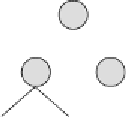Information Technology Reference
In-Depth Information
jump from place to place when this operator works together with gene trans-
position (see Gene Transposition in section 3.3.4 above).
Figure 3.29 shows the gene recombination event that led to creation of the
perfect solution found in generation 2 (chromosome 3). In this case, gene 3
was exchanged between chromosomes 4 and 8 of generation 1, obtaining
a.
012345678012345678012345678
-[mA] = 6
AOaaaabacAbbObcabaNONNbcbbb-[mB] = 6
AcaabbcabAOaAcbbcbNNOAcbbbc
012345678012345678012345678
NONNbcbbb-[dA] = 8
AcaabbcabAOaAcbbcb
AOaaaabacAbbObcaba
NNOAcbbbc
-[dB] = 5
b.
mA:
Sub-ET
1
A
Sub-ET
2
Sub-ET
3
A
N
a
c
a
O
N
c
A
O
c
b
b
A
b
b
Sub-ET
1
Sub-ET
2
Sub-ET
3
mB:
A
A
N
a
O
b
b
O
a
a
N
N
c
b
Figure 3.29.
Illustration of gene recombination and its effects.
a)
An event of gene
recombination. In this case, the parent chromosomes exchanged gene 3, forming
two new daughter chromosomes. Note that both the parents and the offspring
differ among themselves.
b)
The sub-ETs encoded by the parents (before recombi-
nation).
c)
The sub-ETs encoded by the daughter chromosomes (after recombina-
tion) (shown in the next page). Note that the daughter dA is considerably better
than both its parents, encoding a perfect solution to the majority function problem.


















